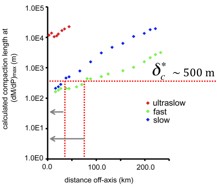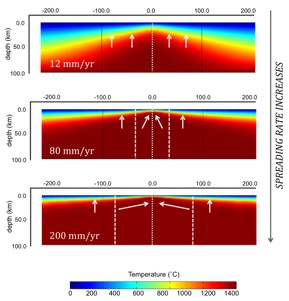Montesi
Spreading-rate dependence of magma extraction processes at mid-ocean ridges
L.G.J. Montési¹* & L.B. Hebert¹
Corresponding author: montesi@umd.edu
¹University of Maryland, Department of Geology, College Park, MD20742
Abstract:
The segment-scale morphology of spreading centers varies with opening rate. Recent numerical models have demonstrated that the transition from axial high to axial valley can be linked to the balance between faulting and magmatic intrusions (Tucholke et al, 2008). In this study, we are exploring how the fault controlling mechanical properties of the ridge and the melt production and extraction system are linked. We estimate the depth of various mechanical definitions of the lithosphere from generic 2D and 3D models of the mantle flow field and thermal structure underneath spreading centers and evaluate the efficiency of various melt extraction processes in these models. Porous magma flow under the influence of spreading-induced pressure gradients is more efficient at faster spreading rates, but low residual melt fractions and the possibility of dissolution instabilities that form vertical channels strongly reduce the efficiency of this process. Melt accumulation and propagation along a permeability barrier is an alternative melt focusing process (Sparks and Parmentier, 1991) but a comparison of ridge morphology at ultraslow spreading rates implies that it loses its efficiency at the slowest spreading rates (Montési and Behn, 2007). Using the thermodynamics modeling software (pH)MELTS (Smith and Asimow, 2005), we compute the expected crystallization rates of magma as they attempt to rise through the lithosphere. A permeability barrier will form only if the crystallization rate exceeds the rate at which the solid matrix can decompact to accommodate the crystals (Korenaga and Kelemen, 1997). We find that the permeability barrier mode of magma focusing may dominate only slow to intermediate-rate spreading center. At ultraslow rates, the thermal boundary layer is deep enough to affect the crystallization sequence and lower the maximum crystallization rate to the point where crystallizing magma are absorbed in the lithosphere rather than focused toward the axis. At the fastest rates, the slope of the permeability barrier is so low that we expect a significant fraction of the magma produced in the mantle will not be focused to the axis. The lowest degree melts are likely injected as off-axis intrusions and possible volcanism. We are exploring the implication of these changes in term of the chemistry of magma collected at the axis.
Keywords:
Melt extraction; spreading rate; mantle flow; crystallization
Contributions to Integration and Synthesis:
While the models described here are generic in the sense that they do not follow the specific geometry of a particular spreading center, they serve to demonstrate the capacity of linking geochemical information with geophysical observable that we can be predicted from segment-specific 3D models. We only discussed the thermal structure of the mantle underneath the ridge, which may be linked to heat flow, flexural parameters, seismic velocity, and possibly the pattern of faulting (Behn and Ito, 2008a, b). A new capacity of our modeling framework is to determine the strain accumulated in the mantle for comparison with seismic anisotropy measurements. This capacity is particularly useful in conjunction with 3D ridge models that follow the geometry of a particular ridge. Although this type of analysis is still underway, we can generate predictions of melt migration, lava chemistry, and seismic anisotropy from a single numerical model. Such self-consistent synthetic datasets need to be compared with actual data to test the conceptual models that have been proposed for each site. We plan to apply this capacity to the EPR9°N area, where seismic velocity, anisotropy, and geochemistry have been suggested to reflect misaligned upwellings, influenced by large-scale mantle flow (Toomey and Hooft, 2008). Gravity anomalies over the same area imply magma transport toward transform domains (Gregg et al., 2007). We can also include in our models the proposed crustal-scale transport mechanisms and identify in our models linked mantle seismic and chemical signals that can be search for in available data.
Figures:
Figure 1. Compaction length for which crystallization of ascending magma is balanced by decompaction, shown as a function of off-axis distance for three different spreading rates (ultraslow: 12 mm/yr, slow: 80 mm/yr; fast: 200 mm/yr). The thick thermal boundary layer at ultraslow ridges induces slow crystallization rates that can be accommodated by matrix decompaction. If a critical compaction length exists (0.5 to 5km), only the magma generated within a critical distance of the axis accumulates and is focused towards the axis. Montesi_fig1.jpg
Figure 2. Interpretation in terms of focusing: magma is absorbed by the lithosphere at ultraslow ridges and focused toward the axis at faster ridges. However, focusing may become less efficient at fast spreading because the permeability barrier is too shallows and horizontal. Montesi_fig2.jpg


